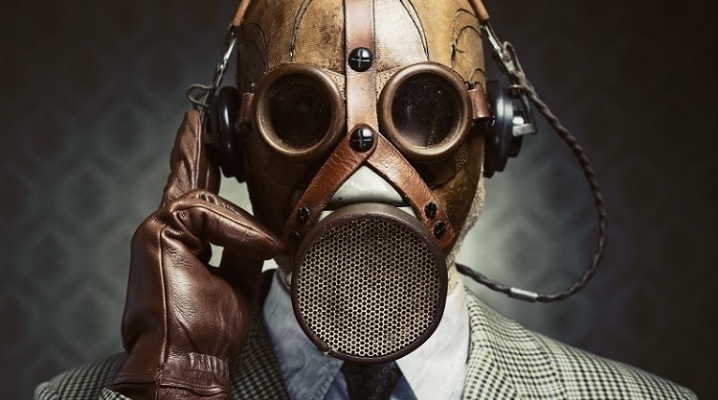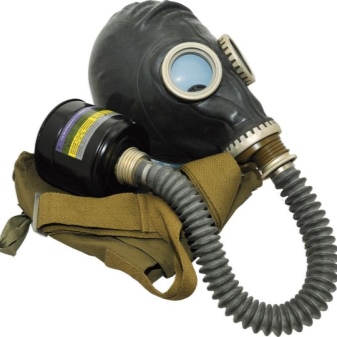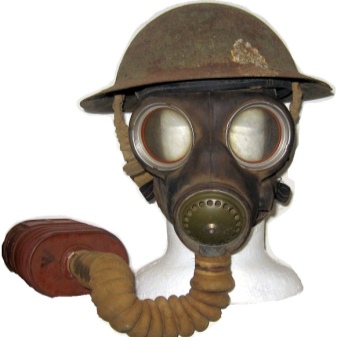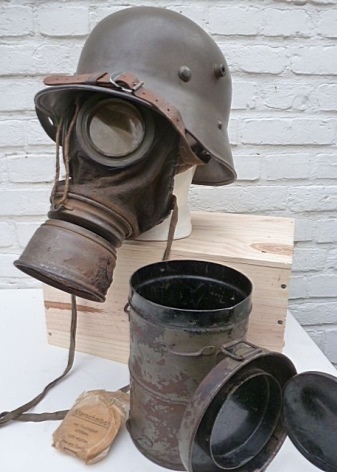The history of the creation of a gas mask

A gas mask is a device for protecting the respiratory system, eyes and skin of the face from damage by various substances distributed in the form of gases or aerosols in the air. The history of such means of protection goes back to the Middle Ages, of course, over a long time there have been significant changes, and not only in appearance, but primarily functional.


From a leather mask with a "beak" and red glasses, which were supposed to protect doctors during plague epidemics, protective means have reached devices completely isolating from contact with a contaminated environment, providing air filtration from any impurities.

Nikolai Zelinsky's invention
About who first invented the prototype of the modern gas mask, there is no unambiguous point of view in the world. The history of the creation of a gas mask is directly related to the events of the First World War. The urgent need for such a means of protection arose after the use of chemical weapons. For the first time, poisonous gases were used in 1915 by German troops.
The effectiveness of the new means of engaging the enemy surpassed all expectations. The technique of using poisonous gases was surprisingly simple, it was necessary to wait for the wind in the direction of the enemy's positions and spray the substances from the cylinders. The soldiers left the trenches without a shot, those who did not make it, died or were incapacitated, most of the survivors died within the next two or three days.


On May 31 of the same year, poisonous gases were also used on the Eastern Front against the Russian army, the losses amounted to more than 5,000 soldiers and officers, about 2,000 more people died from respiratory tract burns and poisoning during the day. The front sector was broken through without any resistance and almost without a shot from the German troops.

All countries involved in the conflict tried hard to organize the production of toxic substances and agents that would expand the possibilities of their use. Projectiles containing ampoules with poisonous gases are being developed, spraying devices are being improved, and methods of using aviation for gas attacks are being developed.
At the same time, there is a search for a universal means of protecting personnel from new weapons of mass destruction. Panic in the leadership of armies can be illustrated by the proposed methods. Some military leaders ordered to kindle fires in front of the trenches, the streams of heated air should, in their opinion, carry the sprayed gases upward and then they would pass over the positions without causing harm to the personnel.


It was proposed to shoot suspicious clouds with guns in order to disperse toxic substances. They tried to provide each soldier with gauze masks soaked in reagent.
The prototype of the modern gas mask appeared almost simultaneously in all the belligerent countries. The real challenge for scientists was that different substances were used to defeat the enemy, and each required a special reagent to neutralize its effect, completely useless against another gas. It was not possible to provide the troops with a variety of neutralizing substances; it was even more difficult to predict which poisonous substance would be used again. Intelligence data could be inaccurate and sometimes contradictory.


The solution was proposed already in 1915 by the Russian chemist Nikolai Dmitrievich Zelinsky, which can rightfully be called one of the creators of the modern gas mask. Being engaged on duty by cleaning various substances with the help of charcoal, Nikolai Dmitrievich conducted a number of studies on its use for air purification, including on himself, and came to satisfactory results.

Due to its exceptional adsorbing properties, specially prepared coal could be applied to any substances known at that time as a means of destruction. Soon ND Zelinsky proposed a method for producing an even more active adsorbent - activated carbon.


Under his leadership, studies were also carried out on the use of coals of various types of wood. As a result, the best were recognized in descending order:
- birch;
- beech;
- pine;
- lime;
- spruce;
- oak;
- aspen;
- alder;
- poplar.


Thus, it turned out that the country has this resource in huge quantities, and providing them with the army will not be a big problem. It turned out to be easy to set up production, since a number of enterprises were already burning charcoal of wood origin, it was necessary to increase their productivity.
Initially, it was proposed to use a layer of coal in the manufacture of gauze masks, but their significant drawback is a loose fit to the face - often reduced the cleaning effect of coal to zero. To the aid of the chemists came a process engineer at the Triangle plant, which manufactures products from artificial rubber, or, as we are accustomed to call it, rubber, Kumant. He came up with a special sealed rubber mask that completely covered the face, so the problem of a loose fit, which was the main technical obstacle to the use of activated carbon to clean the air from toxic substances, was solved. Kumant is rightfully considered the second inventor of the modern gas mask.


The Zelinsky-Kumant gas mask was designed according to the same principle as modern means of protection, its appearance was somewhat different, but these are already details. In the same way, a metal box with layers of activated carbon was sealed to the mask.
Its mass production and the appearance in the troops in 1916 forced the German troops to completely abandon the use of poison gases on the Eastern Front due to their low efficiency. Samples of a gas mask created in Russia were soon transferred to the Allies, and their production was established by France and Great Britain. On the basis of trophy copies, the production of gas masks was launched in Germany.


Further development
Initially, before the use of poisonous gases on the battlefield, respiratory protection was not an attribute of the military. They were necessary for firefighters, people working with aggressive environments (painters, workers in chemical plants, etc.). The main function of such civilian gas masks was to filter the air from combustion products, dust or some toxic substances used to dilute varnishes and paints.

From Lewis Haslett
Back in 1847, American inventor Lewis Halett proposed a protective device in the form of a rubber mask with a felt filter. A special feature was the valve system, which made it possible to separate the flows of inhaled and exhaled air. The inhalation was carried out through a filter insert. A small mask was attached with straps. This prototype respirator was patented under the name "Lung Protector".
The device did a good job of saving dust or other particles suspended in the air. It could be used by workers in "dirty" industries, miners or farmers engaged in the preparation and sale of hay.

From Garrett Morgan
Another American craftsman, Garrett Morgan, offered a gas mask for firefighters. He was distinguished by a sealed mask with a hose that lowered to the floor and allowed the firefighter to breathe cleaner air during rescue work. Morgan quite justifiably assumed that the products of combustion, together with the hot air, rush upward, while below the air, as a rule, is colder and correspondingly cleaner. At the end of the hose there was a filtering felt element. This device really proved to be good in extinguishing fires and carrying out rescue operations, allowing firefighters to stay longer in smoky rooms.
Both of these and a number of other technically similar devices coped well with their tasks before the urgent need to create a universal filter element arose after the use of various toxic substances during the First World War. The use of activated carbon by ND Zelinsky, which has universal properties, marked a new era in the development of personal protective equipment.


Scientists' mistakes
The path of creating protective equipment was not straight and smooth. The chemists' mistakes were fatal. As already noted, one of the most urgent tasks was the search for neutralizing reagents. Scientists needed to find such a substance so that it was:
- effective against poisonous gases;
- harmless to humans;
- inexpensive to manufacture.
A variety of substances were assigned to the role of a universal remedy, and since the enemy did not give time for deep research, practicing gas attacks at any opportunity, insufficiently studied substances were often offered. One of the main arguments in favor of this or that reagent turned out to be the economic side of the issue. Often a substance was recognized as suitable only because it was easier for them to provide the army.


After the first gas attacks, servicemen are provided with gauze bandages. Various, including public organizations, are engaged in their production. There were no instructions for their manufacture, the troops received a variety of masks, often completely useless, since they did not provide airtightness when breathing. The filtering properties of these products were also questionable. One of the most serious mistakes was the use of sodium hyposulfite as an active reagent. The substance, upon reaction with chlorine, released sulfur dioxide, causing not only suffocation, but a burn of the respiratory tract. In addition, the reagent turned out to be completely useless against organic toxic substances used by the enemy.
The discovery of the neutralizing action of urotropine saved the situation somewhat. However, even in this case, the problem of loose fit of the mask to the face remained acute. The fighter had to tightly press the mask with his hands, which made active combat impossible.
The invention of Zelinsky-Kumant helped to solve a whole tangle of seemingly insoluble problems.


Interesting Facts
- One of the first prototypes of a gas mask in Russia were glass caps with flexible hoses, which were used in the gilding of the domes of St. Isaac's Cathedral in St. Petersburg in 1838.
- During the First World War, gas masks for horses and dogs were also developed. Their samples were actively improved until the middle of the 20th century.
- By 1916, all the belligerent states had prototypes of gas masks.
Improvement of instruments went on at the same time, and the constant flow of war trophies led to a rapid, if not deliberate, exchange of ideas and technologies.

In the next video, you will find additional information about the history of the creation of a gas mask.













The comment was sent successfully.